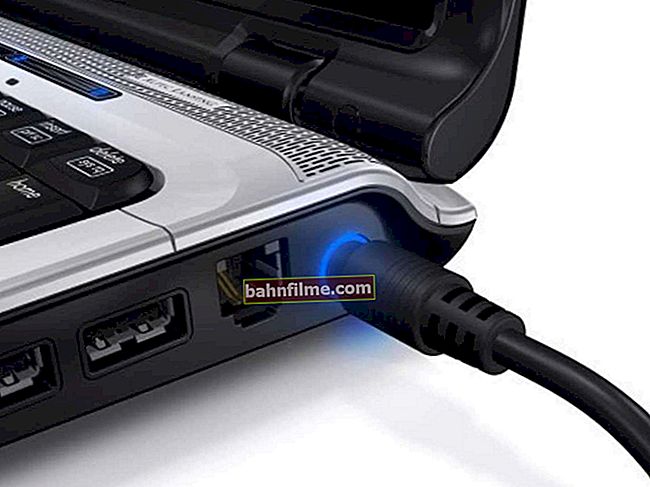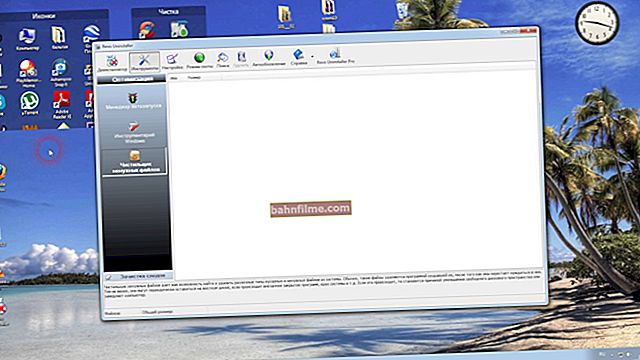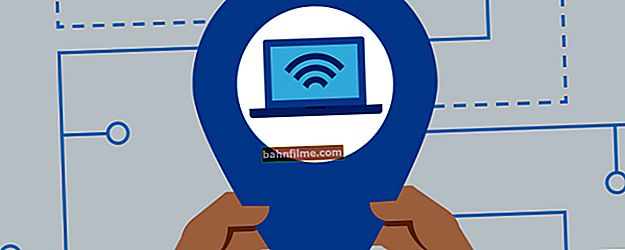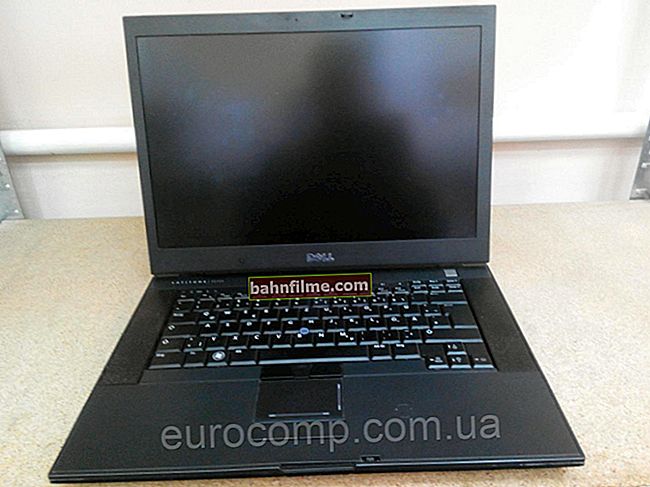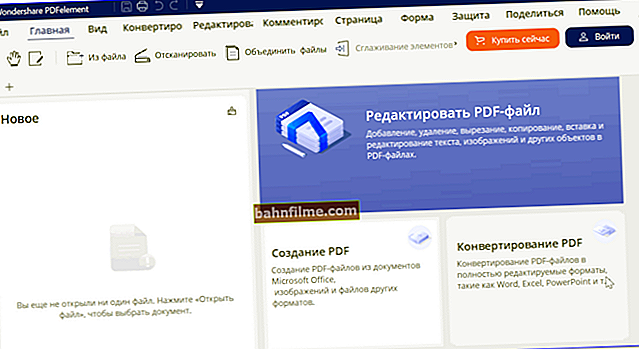 Good day everyone!
Good day everyone!
In the past few years, instead of everyone's familiar BIOS, UEFI began to appear on computers and laptops (in short, for an ordinary user there are not so many differences: there is an opportunity to control the mouse, a graphical interface, support for disks over 2 TB, and the need to prepare an installation flash drives in a special way).
Despite the fact that BIOS and UEFI seem to be similar, but many users (first encountering them) are confused. Yes, and in my articles I often operate with various parameters and settings from UEFI, and the appearance of such a note looks quite logical (there will be where to bring a link where you can clarify what this or that parameter means).
Note: photos and screenshots in the UEFI settings article are from an Asus laptop (ZenBook line). The main sections and parameters in most devices will be identical (although, of course, there may be differences: it is simply unrealistic to give a universal version).
*
Main sections and settings
(on the example of Asus laptops)
How to log into UEFI
In general, just like in the BIOS - there are several ways. I will give them briefly below.
The most common option is to press special. key (on Asus this is usually F2 or Esc) to log in immediately after turning on the device. Moreover, it is advisable to press it several times both before and during the appearance of the logo - until the first UEFI window appears (what it looks like is presented just below in the article).

Press the BIOS entry button (F2 / Esc) several times until the logo appears (and while it is displayed)
Instructions!

How to enter BIOS (UEFI) on a computer or laptop [instructions] - //ocomp.info/kak-voyti-v-bios.html
If you have Windows 8/10 installed (and everything is fine with it, i.e. it boots)
In this case, you can enter UEFI at all without any "searches" for keys. For example, in Windows 10, just open the system settings (Win + i combination) and go to the section "Update and Security" : next restart the computer using special download options (see screenshot below).

Update & Security - Recovery - Special Boot Options / Windows 10
After which the computer will be restarted and a special will appear. menu: in it you need to open the section "Extra options" and run the mode "UEFI Firmware Options" ... Next, you will open UEFI settings, everything seems to be simple ...

Firmware parameters
To help!

Instructions: how to enter UEFI (BIOS) from the Windows 8, 10 interface (without using special keys F2, Del, etc.) - //ocomp.info/kak-voyti-v-bios-iz-windows.html
Control buttons
As in the BIOS in UEFI, all the control keys are also listed for reference (usually on the right). Also, I can't help but note that in UEFI, the parameters can be changed with the mouse (which could not have been imagined before ✌).

Hot Keys - hotkeys (hint in UEFI)
Main control keys:
- Arrows (→, ←): select the settings section;
- Arrows (↓, ↑): select a specific parameter (in an open section);
- Enter: set (fix) the current setting;
- "+" and "-" (press without quotes): change the option (for example, add / subtract something);
- F1: help / help menu;
- F7: enter / exit from the extended menu;
- F9: load default settings (i.e. cancel / reset all parameters to factory presets);
- F10: save all entered settings;
- Esc: Exit the menu / partition (or UEFI).
Sections in UEFI (tabs)
Main window
Appears immediately after you enter UEFI. It contains a lot of useful information:
- processor model;
- the amount of RAM;
- video card model;
- serial number of the device;
- connected drives (hard drives, SSDs, etc.);
- download priority;
- CPU temperature, cooler operating mode, etc.

Asus UEFI (BIOS Utility - Ez Mode) - main window
Pay attention to the bottom of the window (there are all the most interesting things 😉):
- resetting the settings to default (you can also do this by pressing the F9 key);
- call the boot menu (F8);
- advanced settings (F7).
Boot Menu
Boot Menu is necessary in order to view all bootable drives (flash drives, disks, etc.) connected to the device. In essence, this is a list of devices from which you can select one of them and download. For example, it is often necessary to boot from an installation flash drive to install Windows.
To call the Boot Menu - just press the key F8 (or click on this menu).

View the boot menu
Note: the Boot Menu can also be called when the laptop is booted using the special. key (for Asus this keyEsc, you need to press immediately after turning on the device).
Main
The main (or basic) UEFI tab when you go into advanced settings. From it you can learn:
- manufacturer and BIOS / UEFI version (BIOS Vendor, Version);
- processor model (Intel Core i5-7200U);
- the amount of RAM (Total Memory);
- serial number of the device (Serial Number);
- the current date and time (System Date, System Time).

Main Tab
Advanced
One of the main sections for setting many of the most important parameters. I will list the main ones:
- Internal Pointing Device - enable / disable the touchpad (Enabled - this is enabled; Disabled - disabled);
- Wake On Lid Open - an option that is responsible for turning on the laptop when the lid is opened (if you change it to Disabled, then after opening the lid, the laptop will not turn on);
- Intel Virtualization Technology - hardware virtualization (allows you to speed up the device when working with virtual machines. For most users, this option does not give anything - it does not add performance in normal work!);
- Intel AES-NI - an option that speeds up encryption / decoding of protected data (for example, if you use BitLocker, then enabling this option - the decryption speed will be ~ 20% higher *);
- VT-d - I / O virtualization technology (most of them simply do not need this option);
- Asus Ez Flash Utility - the tab is used to update the UEFI version (for advanced users!);
- Smart Settings - provides control over the status of the disk (S.M.A.R.T). If the disk starts to "crumble" - then when you turn on and boot the device, you will see an error that it is time to make a backup (it is highly not recommended to disconnect!);
- Network Stack Configuration - the ability to boot the device using the network. If the device is not used as a server, it should be disabled (in general, a useless option for most);
- USB Configuration - setting up USB operation;
- Graphics Cunfiguration - graphics settings (video card mode *);
- Sata Cunfiguration - configuring the operation of the SATA / IDE controller *.

Advanced - advanced settings
As for the operating mode of video cards (Graphics Cunfiguration tab):
- you can disable the discrete video adapter (that is, so that the laptop always uses only the built-in card). They do this in cases where the discrete card has become unusable (or began to behave unstably), or when they want to extend the battery life of the device;
- DVMT Pre-Allocated is a dynamic video memory technology. In different devices, different values can be distinguished: 32 MB, 64 MB, 128 MB, etc. Does not significantly affect performance ...

Graphics settings
Tab Sata Cunfiguration allows you to change the operation mode of the ACHI / IDE hard drive. For example, when installing Windows OS, it may become so that it does not "see" the hard drive (since it does not have ACHI drivers in its arsenal (usually, it happens with old OS)). By switching the mode to the IDE, you can install the system and deal with the drivers after ...

SATA Configuration - setting the disk mode
Boot
This section, as the name suggests, is responsible for booting the device: here you can specify which media to boot from, whether to use the support mode for older operating systems, etc. When installing Windows, you need to change the settings right here!
About the main parameters of this section (see screen below):
- CSM Support - support for booting old OS (currently Windows 7 and below ...);
- Launch PXE OpROM policy - using this "thing" you can boot Windows over the network (ie, you do not need to use a USB flash drive, disc, or CD-Rom). Most do not need this option, it is not recommended to enable it (there is a risk that you will see a black screen while waiting for the OS to load ...);
- Boot Option (1, 2, 3) is the boot priority: i.e.the computer will first try to boot from drive # 1 - if there are no boot records on it, it will go to drive # 2, etc. As soon as the bootable media is found, the laptop will boot from it, and all other media will not be checked!
- Hard Drive BBS Priorities - a parameter that is responsible for the priority of booting from HDDs (usually, it is not touched, leaving it by default);
- CD / DVD ROM Drive BBS Priorities - similar to the previous point;
- Add New Boot Option - add a new boot device (if your flash drive is not displayed in the list of boot devices - use this option);
- Delete Boot Option - delete a device (line / option with a boot device).

Boot section - boot configuration
Security
This section is responsible for device security: you can set administrator passwords that block changing BIOS settings; you can disable the secure boot mode (the notorious Secure Boot - required to install old operating systems), etc.
I will list the main options:
- Administrator, user password - administrator and user passwords (usually, if they are set simultaneously, the password will need to be entered not only to change the BIOS / UEFI settings, but also to turn on the laptop). If you are worried about the security of data on the HDD, then in my humble opinion, they do not provide much security, because, having taken out your disk from the laptop, it can be read on any other PC;
- I / O Interface Security - blocking / unblocking various interfaces (for example, you can block the operation of USB or LAN);
- Secure Boot - secure boot mode (only supported by new Windows 8, 10). Designed to protect your device from boot viruses.

Security - security settings tab
Save & Exit
Section for saving and resetting settings. In principle, you don't have to go into it if you operate with buttons F10 (this is saving changed parameters) and Esc (this is the exit from the section / tab).
However, here are the main options:
- Save Changes and Exit - save all entered changes and exit (after that the device will be rebooted);
- Discard Changes and Exit - discard all changes and exit (not a single changed parameter will be saved);
- Save Changes - save settings without exiting BIOS / UEFI;
- Discard Changes - discard all changed parameters;
- Restore Defaults - reset all settings to default (factory presets).

Save and Exit
*
That's all for now. All the best!
👣

